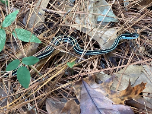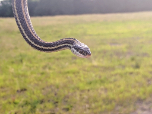Orange-Striped Ribbon Snake (T.p. proximus)
Description: The orange-striped ribbonsnake is a long, slender, colorful type of gartersnake. There are normally two wide, black stripes along the back and a narrow black stripe on each side. The stripe running along the middle of the back is orange or yellow. Along each side is a narrow yellow stripe. The head is black and usually has an orange, yellow, or white spot on the top. The belly is cream colored or light green and is unmarked.
Habitat: Orange-striped ribbonsnakes almost always occur near water: streams, rivers, lakes, ponds, marshes, swamps, roadside ditches, and sloughs. They hide in the border vegetation.
Range: Central United States from Iowa south through Texas and Louisiana, east through Indiana and extreme western Kentucky.
Diet: Ribbon snakes eat small frogs and toads (including tadpoles), salamanders, and small fish. They also eat earthworms.
Reproduction: Mating occurs during April and early May. Not all females reproduce every year. The young are born from July into September. A litter may contain 4 to 36 young, with an average of 12 or 13. Males usually reach sexual maturity in one or two years, and females in up to three years.
Status: Listed as Least Concern because it has a wide distribution, large population, and is unlikely to be declining fast enough to qualify for listing in a more threatened category.
»» Kingdom: Animalia - Animals
»» Phylum: Chordata - Chordates
»» Subphylum: Vertebrata - Vertebrates
»» Class: Reptilia - Reptiles
»» Order: Squamata - Scaled Reptiles
»» Suborder: Serpentes
»» Superfamily: Colubroidea
»» Family: Colubridae - Colubrids
»» Genus: Thamnophis
»» Species: Thamnophis proximus - Western Ribbon Snakes
»» Subspecies: T.p. proximus - Orange-Striped Ribbon Snake
This article uses material from the Wikipedia article "Thamnophis proximus", which is released under the Creative Commons Attribution-Share-Alike License 3.0. Content may have been omitted from the original, but no content has been changed or extended.
|








